Abstract: It has been over twenty years since the late Roger Sutton published information regarding the specimens of the British Large Copper Lycaena dispar dispar and the Scarce Copper Lycaena virgaureae in the Taunton Museum collections. This paper reevaluates these historic specimens, which are now held at the Somerset Heritage Centre in Taunton. Further information is also provided on the Somerset collectors that are thought to have encountered both of those Lycaena species on the Somerset Levels. The paper also mentions the further discovery of early specimens of Large and Scarce Coppers that may have originated in Somerset.
In the collections of the Taunton Heritage Centre are the remains of five specimens of the British Large Copper Lycaena dispar dispar that are said to have been caught in the marshes at Langport in the Somerset Levels during the early part of the 19th century. The collections also contain a specimen of the Scarce Copper Lycaena virgaureae said to be taken at Langport.
The Large Copper was once found in a number of colonies in the fens of Eastern England but became extinct in the middle of the 19th century when the fens were drained (Salmon, 2000).
The Scarce Copper was considered a British species by the early Aurelians. William Lewin was one of the few early Aurelians to correctly identify the Scarce Copper as L. virgaureae. He wrote "In the month of August I once met with two of these butterflies, settled on a bank in the marshes, the sun at that time being very hot on them; they were exceedingly shy and would not suffer me to approach them" (Lewin, 1795). On the continent this species is not normally found in a fenland habitat but it is possible that this extinct butterfly flew in the drier areas in such localities in Britain. There are also records of the Scarce Copper from the East Anglian Fens (Salmon, 2000). In the Dalean collection at Oxford there is a male specimen of L. virgaureae that is labelled with a location of the Isle of Ely. Unfortunately, the activities of unscrupulous 19th century dealers who imported numbers of L. virgaureae from the European continent and sold them as British specimens have caused much confusion (Allan, 1966).
The late Roger Sutton from Taunton studied the origins of the L. dispar and L. virgaureae specimens and produced a detailed paper on them in 1993 (Sutton, 1993). While Sutton was cataloguing the Somerset Lepidoptera collections, he came across the remains of some Lycaena specimens. They had a pencilled note against them: "Possibly the specimens of the Large and Purple-edged Copper butterflies caught by the Quekett brothers". The Purple-edged Copper (Lycaena hippothoe) specimen was in fact a specimen of the Scarce Copper. Sutton found that they were probably captured by another Langport collector, John Woodland. Sutton observed that the specimen pin on one of the Taunton specimens of L. dispar is identical to that on the specimen of L. virgaureae, suggesting that they were caught around the same time. Watkins and Doncaster, the famous natural history suppliers, confirmed to Sutton that the specimen pins were an early 19th century pin but were not entomological.
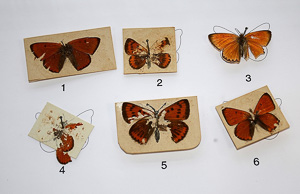 | 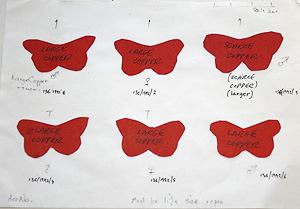 |
| Image © Peter Andrews | Image © Peter Andrews |
| Figures 1, 2 - Specimens of L. dispar and L. virgaureae with their study identification card by R.D. Sutton Image © Collections of the Somerset Heritage centre |
A.E. Hudd produced a list of Lepidoptera for volume one of the "Victoria County History of Somerset" in 1906. Hudd was convinced that the L. dispar specimens in the Taunton museum were formerly taken in Somerset. William Bidgood, curator of the Taunton Castle museum between 1862-1901, also had no doubt that these specimens were taken in Somerset. Bidgood wrote to Hudd: "A specimen (was) in an old collection made in the early part of the century and presented to the Somerset Archaeological and Natural History Society, about 1860, by Mr. Woodland, who told me that it was taken at Langport. There were two or three specimens in the Queckett Museum also, but so badly decayed from damp and moth that there was no chance of saving them; only just enough to swear by" (Hudd, 1906).
In another letter Bidgood wrote to Hudd: "About the year 1864 Mr. Woodland gave me a small collection of butterflies taken near Langport early in the century; among them were two or three P. dispar, which he told me were taken by himself. In his early days he had taken care of them, but he got old and neglected them, so that when they came to me they were dilapidated. I preserved every bit I could. Among them were two or three specimens of the "Purple-edged Copper", P. chryseis, which he informed me were taken with the dispar" (Hudd, 1906).
The specimens Bidgood referred to his his letter to Hudd were, in fact, L. virgaureae and not, as he mentioned, P. chryseis (L. hippothoe) (Sutton, 1993). Many early British entomologists, such as William Bidgood, seemed to have difficulty in correctly separating the Lycaena species. The Purple-edged Copper is now regarded as a very doubtful British species.
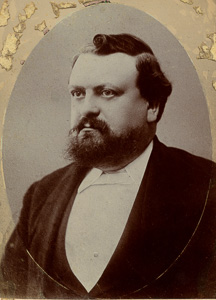 |
| Figure 3 - William Bidgood Image © Somerset Archaeological and Natural History Society |
John Woodland's collection of butterflies and moths, donated in a single cabinet in 1861, has been lost. A search for the cabinet during 1987 proved fruitless (Sutton, 1993). Bidgood made a manuscript of the butterflies contained in the Woodland collection. It is interesting that Bidgood, in his inventory of the Woodland collection, only mentioned there were four specimens of the Large Copper, while there are five specimens in the Heritage Centre. Woodland's collection contained some surprising species. It seems Woodland was at some point in touch with a dealer, for in his collection he had a Green Underside Blue Polyommatus alexis (doubtful British), Apollo Parnassius apollo (doubtful migrant), Camberwell Beauty Vanessa antiopa (rare migrant) and Queen of Spain Fritillary Argynnis lathonia (very rare migrant). However, all this proves is that Woodland was able to procure specimens from a dealer, probably at a much later date than when he captured the Lycaena. The Lycaena dispar are certainly British specimens and he stated he had collected them himself in the marshes near Langport. John Woodland became a banker and later a Justice of the Peace.
William Bidgood also informed A.E. Hudd: "Early in the last century the late Professor Queckett and his brother (a banker at Langport) formed a museum in the "Hanging Chapel" there. This was transferred to our society about 1876–7. The collection had been much neglected, so that when I went to take possession I found everything covered with mildew, moth was playing havoc with the birds and mites with the insects. There were here also three or four dispar, which I was assured by the family were taken at Langport, and also two or three P. chryseis. This was confirmed by Mr. W. Bond Paul, who died in 1896, aged over eighty. He told me he remembered the insects well, but they were taken before his collecting days". The Quekett specimens were almost certainly L. virgaureae and not P. chryseis (L. hippothoe) as Bidgood had wrongly identified the specimen in the Woodland collection (Hudd, 1906).
William Quekett was a headmaster at the school in the small town of Langport and had six children. His sons, John and Edwin (later of microscopy fame) and Edward were keen naturalists and so was their older brother, William. William senior had encouraged his sons to develop their hobbies in the natural sciences and they were all devoted to nature study which intensified during their teens (Ross, 1911). Although the Quekett's father, William, was a well respected member of the community, his salary was only around £25 a year (a small amount at the time) and, with six children, there would have been little spare money. It is known that John Quekett was a friend of John Woodland and, because of their mutual interest in Natural History, Woodland was probably acquainted with all of the Quekett brothers. Edward would almost certainly have known John Woodland because they worked together at the same Langport bank.
John Quekett and his brother, Edward, rented the Hanging Chapel at Langport, part of a 13th century road archway, as a museum between 1834-1875. John Quekett (1815-1861), the microscopist and histologist, went on to become the professor of the Hunterian museum in London. Edward's hobby was bird taxidermy and the small museum also contained his collection of stuffed bird specimens. The year of the museum's opening was notable because 1834 is the year that the great entomologist J.C. Dale first visited Langport to collect the Large Blue Maculinea arion on the Aller Ridge (Newman, 1871). He was certainly accompanied by John Quekett (Newman, 1871) and perhaps, as Salmon (2000) suggests, his younger brother, Edwin John.
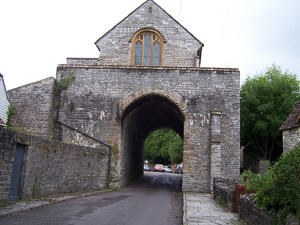 |
| Figure 4 - The Hanging Chapel at Langport, once housed the Quekett museum |
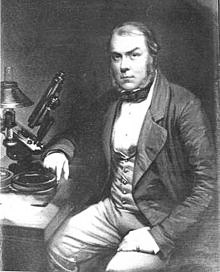 | 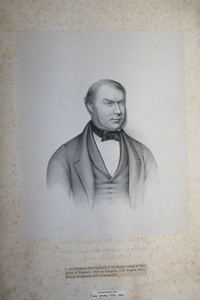 |
| Figure 5, 6 - John Quekett |
During my visit to the Somerset Heritage Centre I was told by the curator, Dennis Parsons, that the Quekett Lepidoptera collection did not survive. The paragraph by William Bidgood above would seem to confirm this. What treasures were lost in the Hanging Chapel? There would, for example, have been the Queketts' fine specimens of M. arion collected by them on Aller Hill.
The low lying marshy ground to the south and west of Langport was part of the area known as the Somerset Levels. This fenland was naturally drained by streams into the River Parrett. Sutton (1993) suggested that L. dispar and L. virgaureae were probably taken when John Woodland and the Queketts around 1820 when they were teenagers, well before the rich fenlands were drained in 1838.
The earliest surviving local Lepidoptera collection was given as a bequest to the Taunton Museum in 1876 by W.G. Rawlinson. William Rawlinson (1840-1928) from Taunton was a wealthy silk manufacturer and a collector of fine art. He placed no data on his specimens. It appears that a few bequests of specimens that were captured by other earlier Somerset collectors have been placed within his collection. For example, while studying the Rawlinson collection, I found specimens of M. arion that were captured by the collector William Bond Paul (1817-1896) at Langport.
In the Rawlinson collection there is a male specimen of L. dispar and a male specimen of L. virgaureae that have early British pins. I believe that these two specimens may not be Rawlinson's and are either those presented by W.B. Paul or, more likely, from the Woodland collection. In Bidgood's letters to Hudd there was some discrepancy as to the actual numbers of L. virgaureae in the collection presented to the museum by Woodland. In his first letter Bidgood mentions a single specimen while later, in another letter to Hudd, there were two or three. If there were in fact three specimens of L. virgaureae collected and presented to the Taunton Museum by John Woodland, then one of these may have been placed at a later date within the Rawlinson collection.
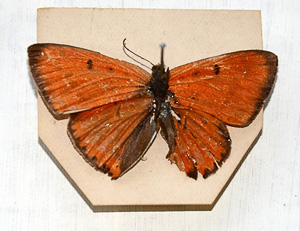 | 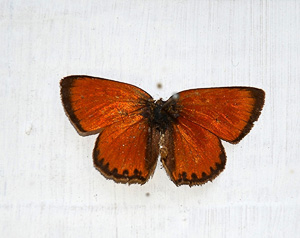 |
| Figure 7 - Large Copper Lycaena dispar in the Rawlinson collection Image © Peter Andrews | Figure 8 - Scarce Copper Lycaena virgaureae in the Rawlinson collection Image © Peter Andrews |
There was another collector, W.D. Crotch From Shrewsbury, who wrote an article entitled "Doings in the West" in the Entomologist's Weekly Intelligencer for 1856. He wrote "C. dispar fell ignobly, slain by the hat of a friend, who kindly made the spoil over to me in utter ignorance of its rarity, and I must regret that my absence from the locality prevents a search, which, if one may trust, the aborigines, would have a fair chance of success". The capture of L. dispar was in the marshes near Brean Down near Weston-super Mare in Somerset. Crotch seems to have been a lucky collector because a little while earlier he had himself taken a Swallowtail Papilio machaon at Weston-Super Mare.
There is a strange episode which concerns I.R.P. Heslop (1904-1970). Heslop, together with Hyde and Stockley, is well known for the monograph "Notes and Views of the Purple Emperor". Heslop took a Mr. John Burton to view a locality on the Somerset Levels where he said the extinct L. dispar once was found. John Burton wrote to R.D. Sutton that Ian Heslop showed him the actual fields where dispar once flew: "He said it used to breed on North Moor and often crossed the road and flew with Maculinea arion".
The last sentence is fanciful to say the least. North Moor was part of Somerset's rich Fenlands. Today, the North Moor area is now a nature reserve consisting of marshy fields and lies some 9 km west of Aller Hill where the extinct M. arion colony occurred. It seems highly unlikely that M. arion would have flown with L. dispar as they frequent entirely different habitats.
John Burton also wrote in his letter to Sutton "dispar was also said to have flown in this area of the Somerset on Lower Salt Moor near Othery and the marshes near King Alfred's Fort (Burrow Mound) near the village of Burrow". Burton believes this information was passed down by W.B. Paul, the Langport collector. Perhaps Burton was given this information by Heslop. Heslop certainly seems to have had information on dispar in Somerset from an unknown source. All of these Somerset Level localities lie between 6 and 10 kilometers from Langport (Sutton, 1993).
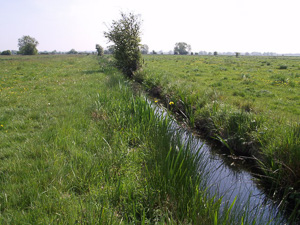 |
| Figure 9 - North Moor where Heslop told Burton dispar once flew |
John Woodland and the Quekett brothers were certainly all experienced naturalists and men of integrity and there is no reason to believe that their specimens of the Large and Scarce Coppers were not of British origin. The actual existence of L. dispar specimens from a local collection and the statements that they were taken on the Somerset Levels seem to be very good evidence that this species perhaps was found there in low numbers in a few scattered colonies. The L. virgaureae specimens in the Heritage Centre and Woodland's statement that he personally captured the species in the Langport Marshes seems to be good indication that it also once occurred there. There are also specimens of L. virgaureae in the Quekett museum. The marshes and fenland once covered a large area around Langport and would have been very difficult to access, possibly suppressing the real numbers of L. virgaureae than might otherwise have been encountered.
I would like to thank Dennis Parsons, the collection manager at the Somerset Heritage Centre in Taunton, for his time and help and allowing full access to the Lepidoptera collections and Butterfly Conservation for providing Roger Sutton's paper. I should also like to thank the Somerset Archaeological and Natural History Society for their permission to use some of their photographs.